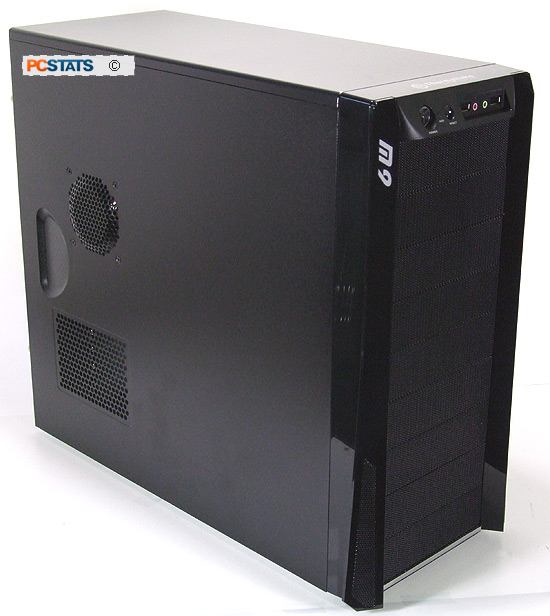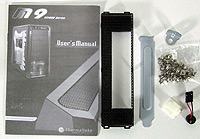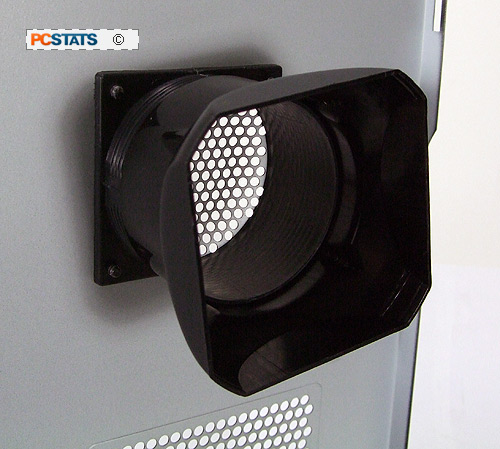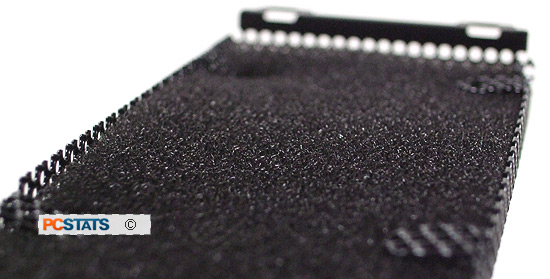The Thermaltake M9 is a mid-tower case that doesn't deviate too much from the generic ATX format
- its 3.5" drives mount parallel to its expansion slots, it's got a pair
of fans in front and rear, and the power supply is mounted on the top of
the case.Thermaltake is trying to stand out from the crowd by throwing in a few
extras; tool-free drive bays, two front panel USB and audio jacks, as well
as a nifty removable hard drive cage. The M9 is a straight forward
case with all the nods towards keeping itself modern and useful.
Thermaltake's M9 stands 17" tall
and 7.5" wide (although that swells out to 9" at its widest point), and is
constructed out of plain old SECC steel, glossy black plastic, and mesh grating along
its front bays.
There's room inside for six 5.25" optical drives and three
3.5" bays in its default configuration, although that can be changed to open up as many as
nine 5.25" bays by removing the hard drive cage.
The M9 case (model: VI1000 BNS) PCSTATS is evaluating retails for $80 CDN,
($70 USD, £40GBP) and doesn't include a power supply or case window.
Other variations of the Thermaltake M9-series (such as the VI1000 BWS
model) ship with a side panel window and either a Thermaltake
400W or 430W power supply.
 |
|
|
Thermaltake Mid-Tower Case |
|
|
 |
| Includes |
|
Instructions and necessary mounting hardware (screws,
brass stand offs and rails), keys, fan scoop. No power supply is
included. |
|

| | |
The front panel of the Thermaltake M9 is made of a
rougher matte black plastic than the glossy fins on the front of the case, which
is good as it keeps greasy fingerprint marks to a minimum. A pair of USB ports
flank a headphone and mic ports - it's a little strange to have the audio jacks
between the USB interfaces, since plugging in a device that uses dual usb cables
(like a portable 2.5" hard drive) will likely require you to remove your
headphones. The close proximity can also cause issues when using a really wide USB
key
and the headphone jack, as one or the other will not
fit.
The power and reset buttons are both recessed into the plastic front panel,
and while the power button is large and easy to press, the reset button is
annoyingly small, and difficult to hit, even with my skinny fingers.
The side panel on the Thermaltake M9 case comes with an
attached air guide, which you can use or leave off. The air guide (or air
scoop as they are called by Antec) help funnel cool intake air from outside
the case to the CPU heatsink fan. This can theoretically help keep CPU temperatures down, but it's also a good idea use the rear
mounted fan to draw hot air out of the case or the chassis will
pressurize and airflow stall. The plastic air guide projects from 3-4" into the case, which
leaves enough clearance for default AMD socket AM2 and Intel socket 775 heatsinks. It may
interfere with CPU coolers taller than 4", but if that's the case
the scoop can be easily unscrewed from the side panel. A standard 80mm fan could also
be mounted to the grill here if you choose.
|

|
The M9's nine 5.25" drive bay covers are made out of metal mesh
with a foam dust filter underneath. The dust filter is a great idea, since
it keeps interior components clean, which in turn helps keep the system cooler
over time. The mesh is flexible, so take care when removing them from the drive bays.
The entire front of the Thermaltake M9 case is covered by 5.25" gratings.

The Thermaltake M9 comes with one mesh
bay cover
and internal railing for a 3.5" drive in the 5.25" space. This is useful
for media card readers, or for users who still have floppy disk drives. The
interior railing is slid into the top 5.25" bay by default, so make sure
to remove it before trying to fit in an optical drive in that slot.

